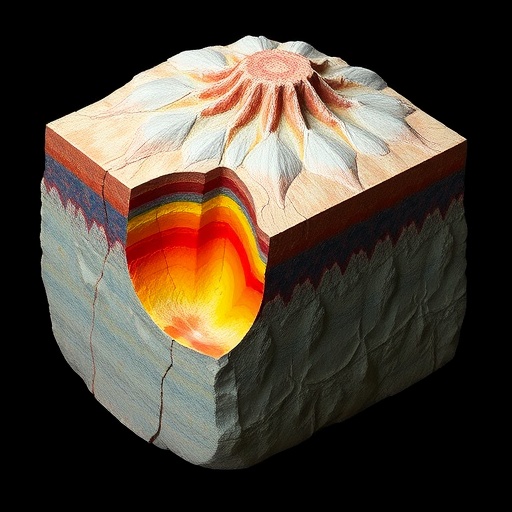Recent research has unveiled groundbreaking insights into the composition and behavior of the mantle beneath the Himalayan-Tibetan orogenic belt, specifically focusing on its carbonate and silicate metasomatism. This transformative work conducted by Li, Yang, Zajacz, and their co-authors offers an unprecedented perspective on how these processes alter the geological features of this complex region, which is renowned for its dramatic terrain and tectonic activity.
The Himalayan-Tibetan orogenic belt stands as one of the most significant geological formations on the planet, resulting from the collision of the Indian and Eurasian tectonic plates. Not only does this collision create towering peaks like Mount Everest, but it also enhances our understanding of deep Earth processes. Recent advances in geochemical analysis and advanced imaging techniques have empowered scientists to probe deeper into the mantle’s mysteries, revealing layers of chemical diversity previously obscured from view.
Metasomatism refers to the alteration of a rock’s chemical composition through fluid interactions, and in this context, the research hones in on two types: carbonate and silicate metasomatism. The study emphasizes the critical role these processes play in shaping the physical and chemical characteristics of the mantle, particularly in areas where tectonic activities are rampant. This dynamic interplay is essential for understanding not just local geology but also broader geodynamic phenomena impacting the Asian continent and beyond.
The researchers employed advanced analytical techniques, including high-pressure experiments, to recreate the conditions of the deep Earth environment. By simulating the geological processes that lead to both carbonate and silicate metasomatism, they were able to track how these interactions contribute to the mineralogical diversity present in the mantle. This is significant because it connects mineral formation processes with the broader mechanisms driving tectonic movements in this seismic hotspot.
One of the key findings of the study is the identification of specific mineral assemblages that develop as a result of these metasomatic processes. The research highlights how carbonates, often overlooked in previous studies, play a critical role in the mechanical and thermal properties of the mantle. Moreover, the interaction between silicate and carbonate minerals generates unique geochemical signatures that can be traced back to surface phenomena such as tectonic uplift and erosion, further connecting surface and subsurface processes.
As carbonate and silicate fluids travel through the mantle, they influence melting processes that lead to the formation of magma. This, in turn, impacts volcanic activities, which are prevalent in surrounding regions. By understanding the intricate details of how carbonates and silicates are distributed in the mantle, scientists can make more accurate predictions about volcanic activity and potential hazards, ultimately enhancing safety and preparedness in populous regions affected by these geological forces.
Importantly, the research provides new perspectives on how the carbon cycle operates at a mantle level, contributing to our understanding of global climate dynamics when viewed over geological timescales. The influx of carbonates into the mantle through subduction may offer clues about the carbon storage capabilities of the Earth’s interior and its implications for long-term climate regulation.
The team’s findings also speak to the processes that underpin the creation of economic resources like gemstones and precious metals associated with these metamorphic environments. The presence of altered minerals derived from carbonate and silicate interactions may serve as indicators of potential mining operations. Such prospects are crucial for economic development in the Himalayan-Tibetan region, where resources need to be harvested sustainably.
The implications of this research extend beyond academic curiosity; they resonate with pressing environmental issues as well. Understanding how the mantle interacts with carbon-containing materials may provide insights into carbon sequestration techniques, which are becoming increasingly urgent in the context of climate change. This study could influence future methodologies for harnessing and managing the Earth’s resources in a way that aligns with sustainable practices.
As science continually progresses toward interdisciplinary approaches, the nexus of geology, environmental science, and climate studies becomes increasingly blurred, revealing a comprehensive framework for understanding the Earth’s inner workings. This research exemplifies how focused geological studies can yield significant implications for broader scientific dialogues, including climate action and resource management.
Additionally, the ongoing research in the Himalayan-Tibetan orogenic belt emphasizes the need for global collaboration among scientists. The complexities of the geological processes discussed require a multifaceted approach, integrating various fields such as geochemistry, petrology, and geophysics to develop a holistic understanding of these dynamic systems. Future studies may benefit from cross-institutional efforts that pool resources and expertise, fostering a new generation of discoveries that could redefine our comprehension of the planet.
In conclusion, the investigation into carbonate- and silicate-metasomatized mantle beneath the Himalayan-Tibetan orogenic belt is a vital step in unraveling the complex interactions that shape our planet. States of matter and mineral assemblages formed deep within the Earth provide vital clues to not just geological processes, but also broader environmental and economic dynamics. As research continues in this domain, the insights gleaned will likely ripple across multiple scientific fields, yielding benefits that extend far beyond geology.
The depth of this study highlights the sophistication of mantle dynamics and establishes a framework for future exploration and discussion. As our technological capabilities improve, so too will our understanding of the Earth’s inner mysteries, making it imperative for the scientific community to engage deeply with these findings in pursuit of knowledge that bridges the gap between our planet’s past and future.
Subject of Research: Carbonate- and silicate-metasomatized mantle beneath Himalayan-Tibetan orogenic belt.
Article Title: Carbonate- and silicate-metasomatized mantle beneath Himalayan-Tibetan orogenic belt.
Article References:
Li, W., Yang, Z., Zajacz, Z. et al. Carbonate- and silicate-metasomatized mantle beneath Himalayan-Tibetan orogenic belt. Commun Earth Environ 6, 814 (2025). https://doi.org/10.1038/s43247-025-02778-0
Image Credits: AI Generated
DOI: 10.1038/s43247-025-02778-0
Keywords: Metasomatism, Mantle Geochemistry, Himalayan-Tibetan Orogenic Belt, Carbon Cycle, Geological Processes, Volcanism, Climate Change, Resource Management.




